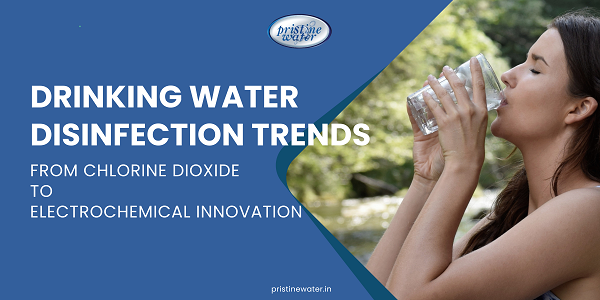
Drinking Water Disinfection Trends: From Chlorine Dioxide to Electrochemical Innovation
Clean and safe drinking water is the foundation of public health. Yet, delivering water that is both microbiologically safe, chemically balanced and affordable remains a persistent challenge worldwide. Growing populations, rapid urbanization, and the increasing impacts of climate change on water sources are straining traditional treatment systems. At the same time, consumer awareness of water quality and stricter government regulations are reshaping how utilities, industries, and communities approach disinfection.
The Shift Toward Advanced Disinfection Methods
For decades, chlorination has continued to be recognized as the most common method of disinfecting drinking water. It is inexpensive, reliable, and ensures residual protection within distribution systems. Chlorine gas cylinders were used to dose chlorine gas into the water for disinfection. This was almost always accompanied by a Chlorine Leak Absorption System. This old technology, while still in use, has given way to the new and improved Electro Chlorinetion, also known as onsite generation of Sodium hypochlorite using salt, water and electricity. Unlike the older chlorine gas technology or using commercial sodium hypochlorite (also known as bleach), electrochlorination significantly reduces safety risks and logistical challenges.
Key advantages of electrochlorination include:
- Safety first – No need to store or transport hazardous chlorine cylinders or chemicals to the locations which are often away from the large cities.
- Sustainability – Lower carbon footprint, reduced packaging, and fewer transport emissions. By locally producing the disinfectant using common ingredients available easily anywhere, you remove the dependency on the constant restocking of the chemical consumable.
- Cost efficiency – Long-term savings by producing disinfectant on demand. No need to depend on chemicals that need to be restocked ever so often.
- Scalability – Suitable for large municipal water systems, offshore oil platforms, power plants, and even rural community water supplies.
Pristine Water has been a pioneer in electrochemical treatment technologies for over 40 years. Our electrochlorination systems—available in both seawater and brine-based designs—are widely used in municipal water supply, power plants, refineries, offshore platforms, and desalination projects.
The integration of IoT and AI technologies is further strengthening this trend. Utilities can now monitor water quality parameters in real time, optimize dosing, and predict contamination risks before they spread. This combination of electrochemistry and digital intelligence is reshaping water disinfection into a proactive, responsive process rather than a reactive one.
Some other methods gaining traction to disinfect drinking water are:
-
Chlorine dioxide is highly effective at lower concentrations, produces minimal byproducts, and works across a broad pH range. It is widely used for hospital water systems, food processing, and municipal applications where pathogen control is critical. Pristine Water makes chlorine dioxide systems for several different applications and capacities.
-
Reverse Osmosis is a suitable drinking water treatment method because it uses pressure to push water through a semi-permeable membrane, to filter out dissolved solids, minerals, bacteria, and other contaminants to produce pure, safe water. This multi-stage process efficiently removes a wide range of impurities, improving taste and odor, and is a reliable way to get potable water from sources like brackish water and even seawater. Pristine Water makes complete RO systems for large scale water treatment.
-
Ultraviolet (UV) radiation UV disinfection is surging globally due to its ability to inactivate chlorine-resistant pathogens such as Cryptosporidium and Giardia. With no chemical residues, UV systems align with consumer preferences for “chemical-free” water treatment.
-
Ozonation & advanced oxidation processes (AOPs) Ozone is a powerful oxidant that not only disinfects but also breaks down organic contaminants and removes odors. Advanced oxidation processes (like ozone + UV or hydrogen peroxide + UV) are being deployed in high-demand environments where ultra-pure drinking water is essential.
These solutions are often adopted in combination, creating multi-barrier approaches that balance cost, effectiveness, and safety. Regulatory and Market Drivers
Regulations and infrastructure investments are playing a decisive role in shaping disinfection technologies:
- Stricter water quality standards – Many countries are tightening allowable limits for DBPs, compelling utilities to explore chlorine dioxide, UV, and electrochlorination.
- Pathogen control mandates – Growing concerns around Legionella and other opportunistic pathogens in hospitals, hotels, and public facilities are pushing adoption of chlorine dioxide and real-time monitoring systems.
- Investment in water infrastructure – India and China, in particular, are scaling up electrochemical and UV-based disinfection as part of their national water safety programs.
- Global push for sustainability – Governments and corporations alike are prioritizing solutions that reduce chemical transport, lower carbon emissions, and enhance community resilience.
These drivers ensure that advanced disinfection systems are not just a technological upgrade but a regulatory and social necessity. Pristine Water has worked with municipal boards and industrial clients to install large-scale electrochlorination systems that comply with the latest water safety regulations.
Conclusion
Drinking water disinfection is no longer just about killing pathogens—it’s about achieving a balance of safety, sustainability, and consumer satisfaction. While traditional chlorination still holds relevance, alternatives like chlorine dioxide, UV treatment, ozonation, and onsite electrochlorination are rapidly becoming the preferred choices.
At Pristine Water, we specialize in delivering electrochemical disinfection solutions, including electrochlorination, Reverse Osmosis and chlorine dioxide systems that help industries and communities meet these emerging challenges. By combining innovation with decades of experience, we’re contributing to a safer and more sustainable future in water treatment.”
